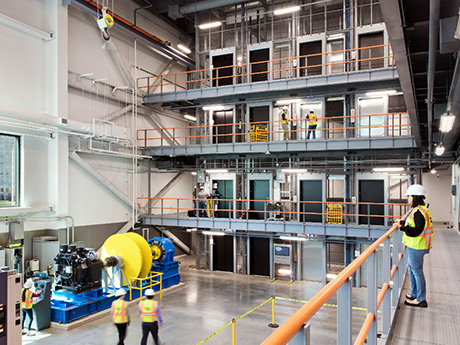By John Haba, principal, Gensler Houston
The demands of global economics and trade continue to evolve in the wake of rapid digital transformation. There is an urgent need to build more resilient supply chains and infrastructure as international disruptions impact local economies. With this shift comes a great opportunity for industrial and logistics facilities to become more efficient, responsive and resilient.
A key consideration in the evolution of the industrial sector is how a company embraces safety culture. Safety culture focuses on preplanning the processes needed to achieve an end goal while also continuously and purposefully reviewing and optimizing that goal as it relates to safety, quality, cost and constructability.

There is demonstrated value in having architecture, engineering and construction consultants understand the significance of safety culture because it allows for “outside the box” thinking to bring value to a solution. This leads to efficiencies in construction and operations, an increased quality of work and a better value proposition.
Efficiencies in Construction, Operations
Today, site selection is more challenging than ever before, primarily due to the connectivity of infrastructure and systems, including water, electrical, gas, sewage and more recently, data. This is also compounded by the historical issue of community pushback.
However, as companies operate in a safety-culture mindset, there are opportunities to unlock the potential of complicated or complex sites that are otherwise overlooked. It’s important to understand that any facility will, to some degree, involve a multimodal component. Both throughput, or efficiencies of production and/or processes, and safety should be regarded as equally important as the ability to get on and off the site.
The Gensler team developed a successful safety strategy for Matec’s semiconductor facility in Brazil, which addressed hazards brought on by the development location. The owner selected a site along a mountainside with very harsh terrain. The tight site had to accommodate daily flammable liquid deliveries while providing a safe working environment for personnel.
The final design offered a highly effective clean room facility that was zoned for safety and performed as an effective, flexible, state-of-the-art laboratory environment. To achieve a highly sophisticated finished product, the team engaged in extensive laboratory planning with the end users to not only understand their processes, but to improve upon their workflow efficiencies.
Transition zones should also be considered in the design and planning process. It is essential to provide employees with the opportunity to refocus on safety culture. For example, spaces can be deliberately created for employees exiting one area, such as a lab, and transitioning to another, like an industrial environment. This lets an individual reset and refocus on their surroundings in an intentional way.
Increased Quality of Work
Safety culture is built around purposeful preplanning, and as a result, an increased quality of work is naturally seen.
For example, when machines and automation are assigned dangerous and monotonous tasks, we can expand the skill sets of factory workers and allow them to focus on creative problem solving. As the industry’s war for qualified personnel prevails, a refined focus on employee health and well-being will help retain and attract talent.
If employees understand that spaces can be designed to facilitate the implementation of safety culture and all of its associated benefits, stress levels can be reduced, profitability can increase and the execution of processes can be done at a higher level.
This mindset is also exemplified in instances where catastrophic events have caused companies to develop safety culture. With a focus on preventing future incidents, companies may choose to require that project partners operate with a similar safety standard or risk the possibility of losing the work. An elevated set of expectations demands that all parties involved prioritize overall well-being and focus on the various processes to deliver a quality finished product.
A Better Value Proposition
In our work, we’ve found that companies that dedicate the time and effort toward being champions of safety culture ultimately see better returns on investment. If an organization embeds safety culture in its ethos and processes from the onset, designers can implement more sophisticated solutions.
Furthermore, positioning safety culture as a workplace amenity results in higher engagement. With a higher engagement rate comes a valuable feedback loop of workers participating in the process because safety culture has empowered them to be more conscious and connected.
“Having an inclusive safety culture is one of the ways to help foster social interaction and relationships at work,” says John Anderson, head of real estate for TK Elevator. “When safety is successfully weaved into a company’s culture and leadership, employees feel the organization values them and embraces the bond to protect and support employee well-being. This team spirit is then felt as a sense of belonging and is fundamental for positive employee engagement.”
Additionally, the ancillary benefit is that as an employee is aware of what they’re doing, there’s a possibility that he or she could see a better way to complete the current task or refine the process.
Conclusion
For most of us, until recently, industrial and logistics facilities were architectural typologies that existed elsewhere — whether overseas or far away from our population centers where land and labor is less expensive. The demands of global economics and trade allowed many of us to consider these facilities “out-of-sight and out-of-mind.”
Today, we are seeing more facilities pop up closer to, and even within, our cities and communities. We must now attempt to anticipate what the industrial facilities of the future will require. In addition to zoning, resident pushback and pollution ordinances, it’s important to consider safety culture in a pitch to construct an industrial facility. Leading with a safety-culture mindset will establish efficiencies in construction and operations and offer an increased quality of work and a better value proposition — creating a better workplace for all
An experienced project director and principal, John Haba was instrumental in establishing Gensler’s industrial and logistics practice area in 2023, and he is often called upon as a subject matter expert. John is a dedicated member of the local arts community and serves on the Aurora Picture Show board. He received a Master of Architecture from The University of Texas at Austin and a Bachelor of Arts in Art History from Oberlin College.


